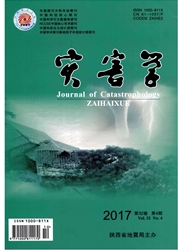

 中文摘要:
中文摘要:
自然灾害社会易损性不仅是自然灾害应急响应管理研究的热点,更是生态环境脆弱与活跃地震带叠加影响下西南民族山区可持续发展研究的重要切入点。基于2012-2015年岷江上游山区25个自然灾害社会易损性评价指标,运用投影寻踪—因子分析,筛选构建出社会经济与保障易损性、社会弱势人口易损性、社会发展阶段易损性3因子的指标体系,并进行易损性综合评价及主控要素分析。结果表明:(1)易损性指数跨度较大,经济发展水平与投入是社会保障能力及发展阶段易损程度高低的决定性因素;(2)易损性指数逐年下降,旅游业带动的经济发展与精准扶贫对易损性影响的正效应逐步提升;(3)道路密度、社会保障和就业支出、女性人口、14岁以下人口、60岁以上人口以及最低生活保障人数指标是社会易损性的重要指示指标,应在精准扶贫实践中予以重点关注。
 英文摘要:
英文摘要:
Social vulnerability to natural disasters is not only the focus of management research of natural disaster emergency response,but also is an important entry point of sustainable development in southwest minority mountainous area with fragile ecological environment and active seismic zone. Based on 25 evaluation indexes of social vulnerability to natural disasters in the upper reaches of Min River in 2012 ~ 2015,using projection pursuitfactor analysis,social security and economic vulnerability,social vulnerable population vulnerability and social development stage vulnerability 3 factors indexes system was constructed,and comprehensive evaluation of vulnerability and analysis of main control factors were given. The results are as follows: 1) the vulnerability index has a large span,the level of economic development and investment is the decisive factor of the social security ability and the vulnerability level of the development stage; 2) Value of vulnerability index declines year by year,the positive effects of tourism-driven economic development and precision poverty alleviation on vulnerability are progressively;3) Road density,expenditure for social security and employment proportion,the proportion of female population,population under the age of 14,the proportion of the population over the age of 60 and the proportion of the minimum living guarantee are important indicators of social vulnerability assessment,should be focus on the practice of precision poverty alleviation.
 同期刊论文项目
同期刊论文项目
 同项目期刊论文
同项目期刊论文
 期刊信息
期刊信息
